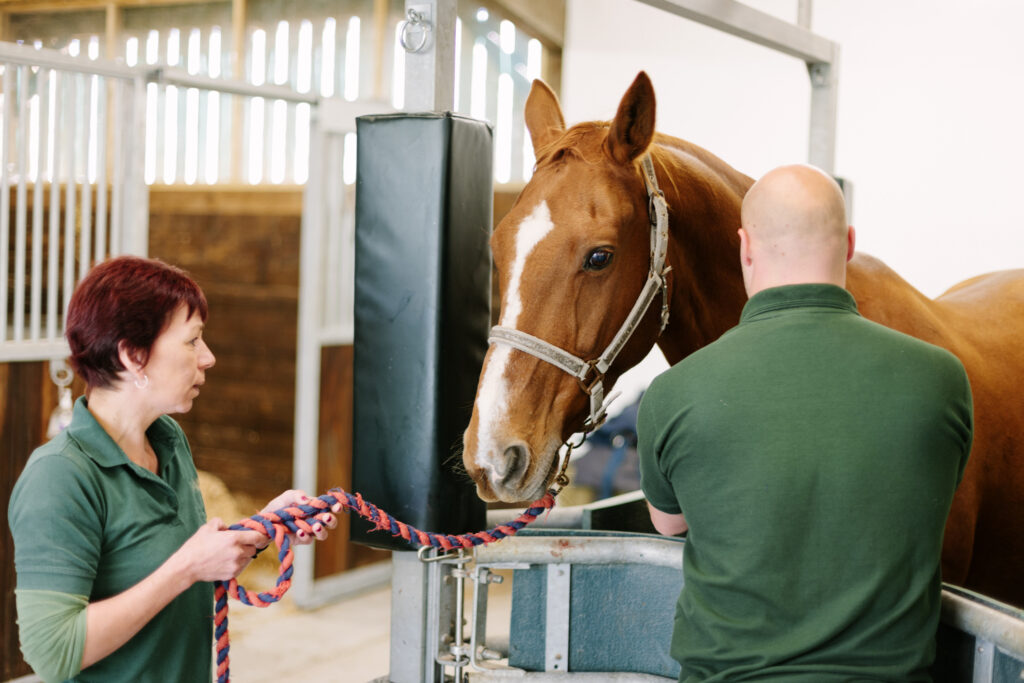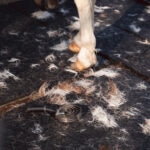What Is Strangles in Horses? What Are the Signs?

Photo by urbancow/E+ via Getty Images
Strangles in horses is a highly contagious infection that requires quick action from horse owners if symptoms are noticed. Strangles is a reportable disease, which means any case must be reported to the state veterinarian and the horse must be quarantined.
It’s important to understand what causes strangles in horses, the signs to look for, and how to help your equine companion start feeling better.
Key Takeaways
- Strangles in horses is a serious infection that can spread quickly among horse populations.
- Equine strangles causes swollen lymph nodes that may eventually become painful abscesses.
- Vaccines are available to help prevent strangles in horses.
What Is Strangles in Horses?
Strangles is a highly contagious bacterial infection that affects horses worldwide. One study from the Georgia Department of Agriculture suggests that the infection rate of equine strangles can be up to 100% in close-knit herds, while the mortality rate is less than 10% thanks to advancements in equine medical care.
“Younger horses, unvaccinated horses, and those with weakened immune systems are most susceptible to the disease,” says Selena Young, DVM, at Cleary Lake Veterinary Hospital in Prior Lake, Minnesota.
Strangles can also spread very quickly in areas where there are high horse densities. This includes horse shows, auctions, and large boarding facilities.
Emma Bliss, DVM, a mixed animal veterinary practitioner, warns that strangles “can also manifest into other syndromes like ‘bastard strangles’ that affect the lymph nodes throughout the body. [This is] where the immune system becomes aggravated and [lymph nodes] swell up in various places around the body.”
What Are the Signs of Strangles in Horses?
Some horses with strangles may experience most of the following symptoms, while others will experience just a few. If your horse experiences any symptoms that you’re unsure about, always call your veterinarian.
Signs of strangles in horses may include:
- Fever
- Depression
- Muscle weakness
- Joint stiffness
- Eye discharge
- Mucous in the airways
- Moist cough
- Loss of appetite
- Difficulty swallowing
- Swollen lymph nodes (may eventually become abscesses) under the jaw
Any horse with a fever should be immediately isolated and assessed by a veterinarian. If a horse is reluctant to eat or shows signs of lymph node enlargement, a vet should also be called out.
What Causes Equine Strangles?
Many people believe that strangles is caused by a virus, but it’s actually caused by the highly contagious gram-positive bacteria Streptococcus equi subspecies equi.
Equine strangles is spread directly from an infected horse to a healthy one via nose-to-nose contact. It can also be spread indirectly through contaminated housing, water sources, feed, tack, or other equipment.
How Is Equine Strangles Diagnosed?
To diagnose strangles, your vet may:
- Collect swabs from various locations such as nasal discharge, abscesses, and the back of the throat. Nasopharyngeal (upper part of the pharynx connecting with the nasal cavity) washes and guttural pouch lavages also help to obtain samples.
- Run samples of a bacterial culture or PCR analysis. Blood tests can also be used to detect antibodies against strangles, which indicate exposure to the bacteria.
How Do Veterinarians Treat Strangles in Horses?
Treatment will be based on severity and clinical signs the horse is experiencing when examined by a vet.
Treatment for strangles varies with each case, but all treatments include rest and supportive care. Horses that experience abscesses may be treated with anti-inflammatories, hot packs, and flushing lymph nodes that may have opened up and are beginning to drain.
If the infection resides within the horse’s guttural pouches, treatment may include local lavage (wash) of the pouches and infusion of antibiotics.
Recommended Product
How Can I Help My Horse Feel More Comfortable?
Horses will find pain relief with the use of anti-inflammatories. It’s important to always follow your veterinarian’s instructions and recommendations for your own horse.
A few other tips may help horses feel more comfortable. “Hot-packing swollen lymph nodes multiple times daily will help soothe the area and encourage the abscess to mature,” says Dr. Young. “In addition, ensure they always have access to fresh water and feed. Those with markedly enlarged lymph nodes, may benefit from having their feed elevated off the ground and feeding mashes (like senior grain) to entice appetite.”
Recommended Product
How Do I Prevent Strangles in My Horse?
Horse owners can be proactive a few ways in preventing strangles, including:
- Vaccinate your horse against strangles
- Isolate new horses for two to three weeks upon arrival and take their temperatures daily
- Routine hygiene practices around the barn
- Empty and disinfect community water tanks on a regular basis with products such as diluted bleach or chlorhexidine
- Don’t share equipment between horses
- Limit exposure to unknown horses during travel
Recommended Product
FAQs About Strangles in Horses
What are the first signs of strangles in horses?
The first sign of strangles in horses is a sudden onset of a fever, lethargy, and poor appetite. Enlarged lymph nodes on the jaw may appear about a week later.
Can horses recover from strangles?
Yes, a horse can recover from strangles with supportive care based on the symptoms they are presenting.
What kills strangles in horses?
The immune system ultimately kills strangles after the abscesses have been drained. However, supportive care and antibiotics in severe cases can help get rid of the infection. You can kill strangles on contaminated surfaces with diluted bleach, chlorhexidine, or Virkon disinfectant.
How does a horse get strangles?
Horses get strangles through direct contact with an infected horse or indirectly through the contact of contaminated items such as tack, feed, or water sources.






